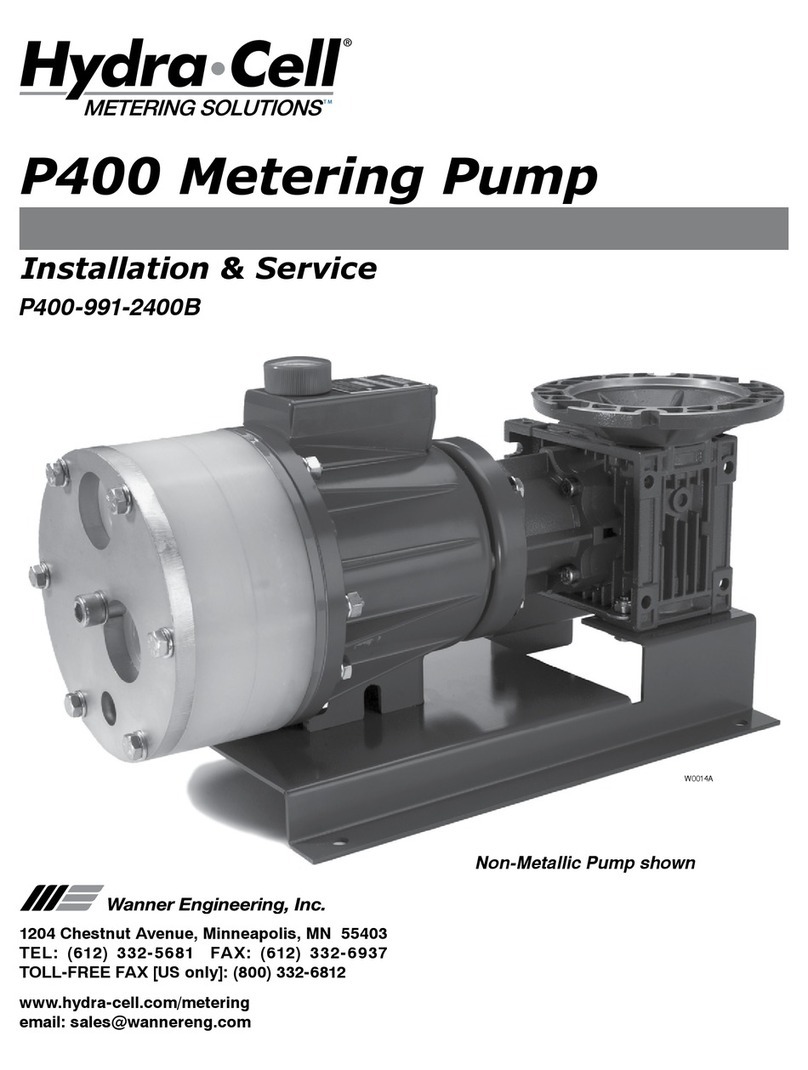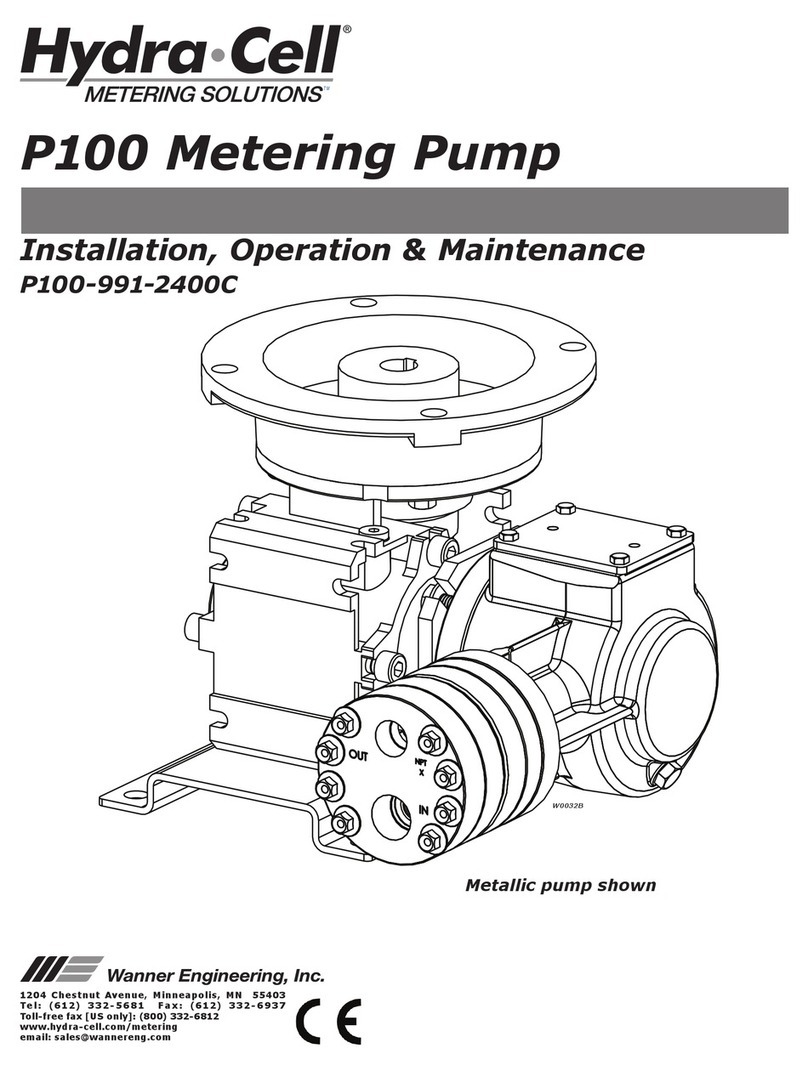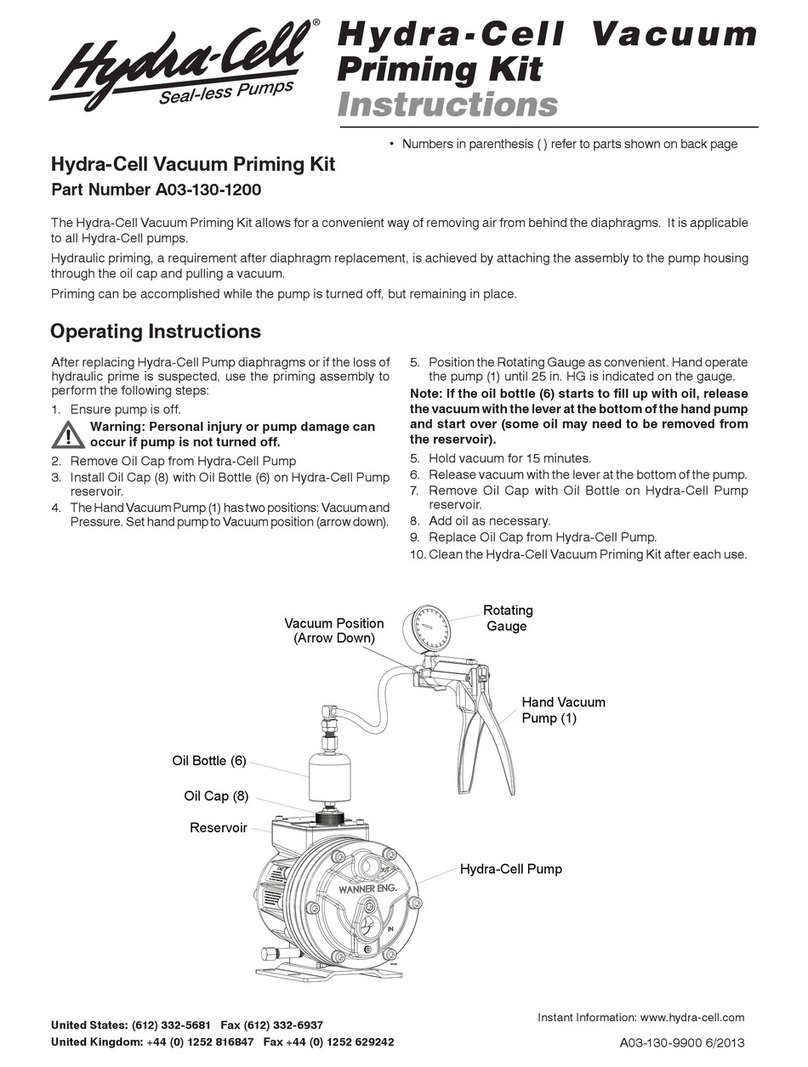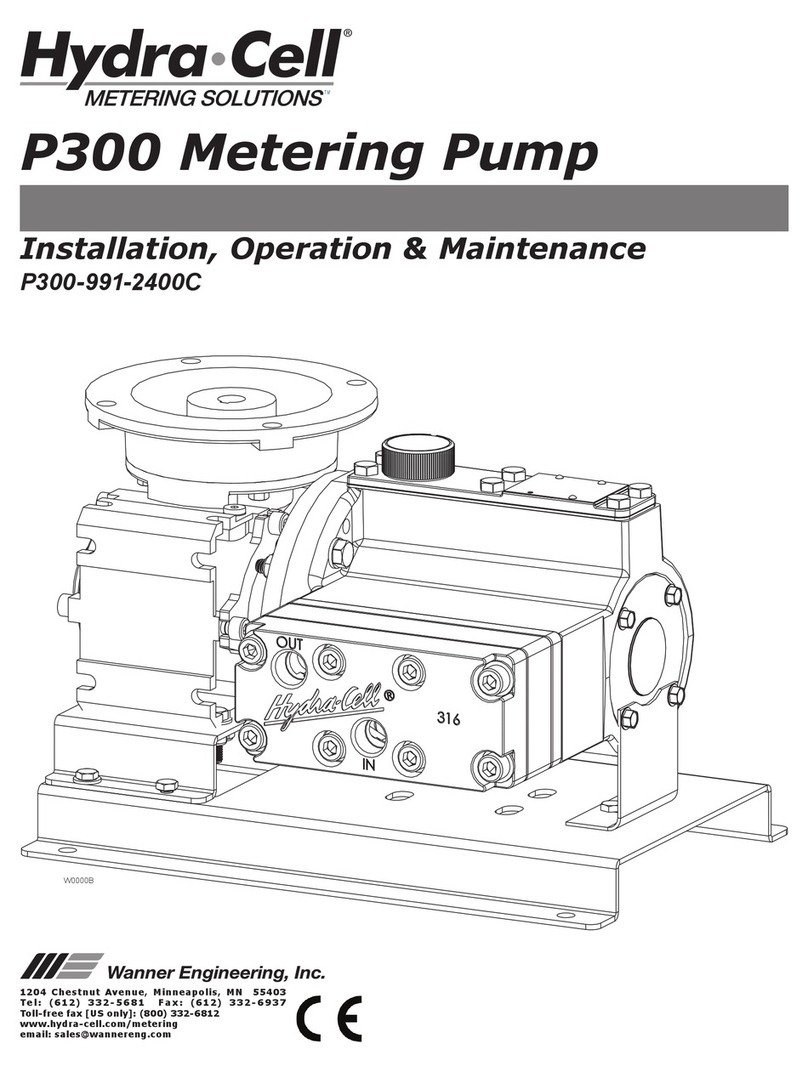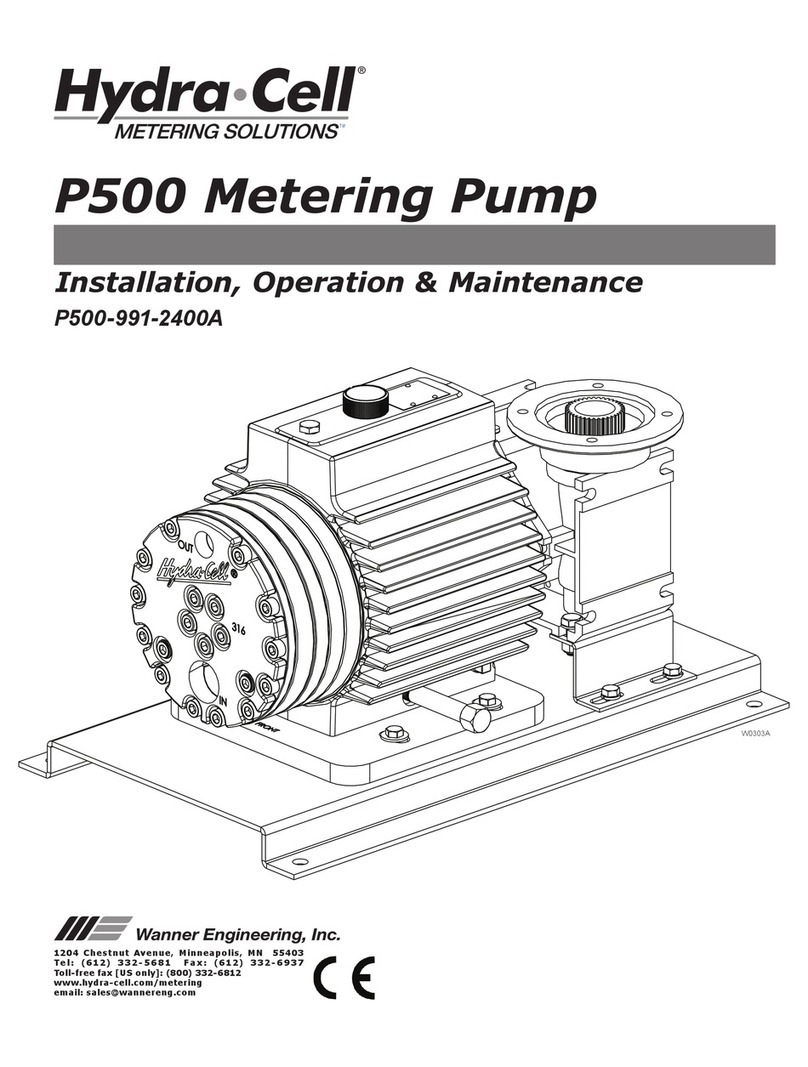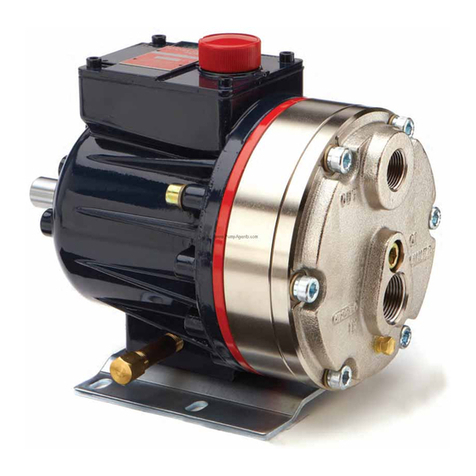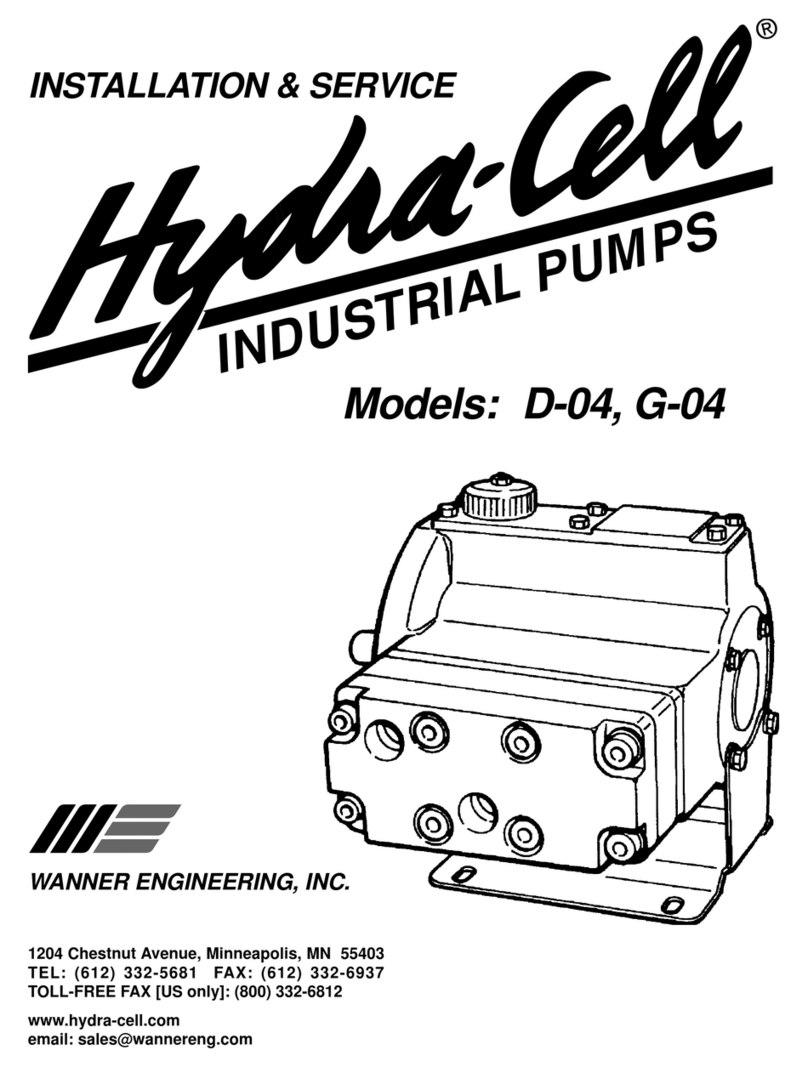
7177-998D
T100 Series High - Installation (Cont’d)
Do not use a line strainer or lter in the suction line unless
regular maintenance is assured. If used, choose a top loading
basket. It should have a free-ow area of at least three times
the free-ow area of the inlet.
Install piping supports where necessary to relieve strain on the
inlet line and to minimize vibration.
Inlet Piping (Pressure Feed)
Provide for permanent or temporary installation of a vacuum/
pressure gauge to monitor the inlet vacuum or pressure.
Pressure at the pump inlet should not exceed 500 psi (34.5 bar);
if it could get higher, install an inlet pressure reducing regulator.
Do not supply more than one pump from the same inlet line.
Inlet Calculations
Acceleration Head
Calculating the Acceleration Head
Use the following formula to calculate acceleration head losses.
Subtract this gure from the NPSHa, and compare the result to
the NPSHr of the Hydra-Cell pump.
Ha = (L x V x N x C) ÷ (K x G)
where:
Ha = Acceleration head (ft of liquid)
L = Actual length of suction line (ft) — not equivalent length
V = Velocity of liquid in suction line (ft/sec) [V = GPM x (0.408
÷ pipe ID2)]
N = RPM of crank shaft
C = Constant determined by type of pump — use 0.066 for
the T100S Hydra-Cell pumps
K = Constant to compensate for compressibility of the uid —
use: 1.4 for de-aerated or hot water; 1.5 for most liquids;
2.5 for hydrocarbons with high compressibility
G = Gravitational constant (32.2 ft/sec2)
Friction Losses
Calculating Friction Losses in Suction Piping
When following the above recommendations (under “Inlet
Piping”) for minimum hose/pipe I. D. and maximum length,
frictional losses in the suction piping are negligible (i.e., Hf = 0)
if you are pumping a water-like uid.
When pumping more-viscous uids such as lubricating oils,
sealants, adhesives, syrups, varnishes, etc., frictional losses in
the suction piping may become signicant. As Hf increases, the
available NPSH (NPSHa) will decrease, and cavitation will occur.
In general, frictional losses increase with increasing viscosity,
increasing suction-line length, increasing pump ow rate, and
decreasing suction-line diameter. Changes in suction-line
diameter have the greatest impact on frictional losses: a 25%
increase in suction-line diameter cuts losses by more than two
times, and a 50% increase cuts losses by a factor of ve times.
Consult the factory before pumping viscous uids.
Minimizing Acceleration Head and Frictional Losses
To minimize the acceleration head and frictional losses:
• Keep inlet lines less than 6 ft (1.8 m) or as short as possible
Accessories
Consult installation drawing below for typical system components.
Contact Wanner Engineering or the distributor in your area for
more details.
Inlet Piping (Suction Feed)
Install drain cocks at any low points of the suction line, to permit
draining in freezing conditions.
Provide for permanent or temporary installation of a vacuum
gauge to monitor the inlet suction. To maintain maximum ow,
NPSHA must exceed NPSHR (See chart in Specications
Section). Do not supply more than one pump from the same
inlet line if possible.
Supply Tank
Use a supply tank that is large enough to provide time for any
trapped air in the uid to escape. The tank size should be at
least ve times the maximum pump ow rate (in gpm or lpm).
For example: at a maximum rate of 45 gpm, since trapped air
takes ve minutes to escape from water, 5 x 45 = 225 gallons
for a recommended supply tank size.
Isolate the pump and motor stand from the supply tank, and
support them separately.
Install a separate inlet line from the supply tank to each pump.
Install the inlet and bypass lines so they empty into the supply
tank below the lowest water level, on the opposite side of the
bae from the pump suction line.
If a line strainer is used in the system install it in the inlet line
to the supply tank.
To reduce aeration and turbulence, install a completely submerged
bae plate to separate the incoming and outgoing liquids.
Install a vortex breaker in the supply tank, over the outlet port
to the pump.
Place a cover over the supply tank, to prevent foreign objects
from falling into it.
Hose and Routing
Size the suction line at least one size larger than the pump inlet,
and so that the velocity will be 1-3 ft/sec (0.3 to 0.9 m/s):
For pipe in inches: Velocity (ft/sec) = 0.408 x GPM/Pipe ID2
For pipe in mm: Velocity (m/sec) = 21.2 x LPM/Pipe ID2
Keep the suction line as short and direct as possible.
Use exible hose and/or expansion joints to absorb vibration,
expansion, or contraction.
If possible, keep suction line level. Do not have any high points
collecting vapor unless high points are vented.
To reduce turbulence and resistance, do not use 90° elbows.
If turns are necessary in the suction line, use 45° elbows or
arrange sweeping curves in the exible inlet hose.
If a block valve is used, be sure it is fully opened so that the ow
to the pump is not restricted. The opening should be at least the
same diameter as the inlet plumbing ID.
